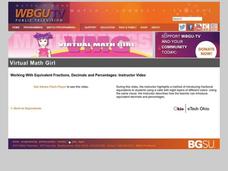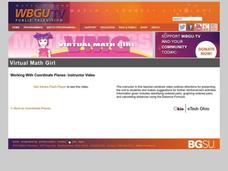Krista King Math
Prime Factorization and Product of Primes
Demonstrate a method for finding the prime factorization of numbers using factor trees and a video that explains how to break a number down to its prime factors. The instructor reinforces the concept of factors by displaying the number...
Krista King Math
Prime and Composite Numbers
Create an understanding of prime numbers with the class after watching a video that examines different numbers and recognizes prime numbers as being those that do not have other factors than one and itself. The narrator then identifies...
Krista King Math
Absolute Value
Investigate with your classes the meaning of absolute value. Here, the instructor explains the definition of absolute value and uses the definition to evaluate different expressions. The expressions include simplifying within the...
Krista King Math
Signed Numbers, Division
Teach dividing with both positive and negative integers by utilizing the video lesson. The instructor gives tricks for recognizing when the quotient will be positive and negative. She works out several examples of different combinations...
Krista King Math
Signed Numbers, Addition and Subtraction
Take the fear out of signed numbers. An educational video explains signed numbers as keeping the sign when both are the same, and offers tricks for what to do when one is positive and the other is negative.
Krista King Math
Opposite of a Number
While the standards don't call for negative numbers to be taught before the sixth grade, many students benefit from learning the concept earlier. A video explains what teachers mean by the opposite of a number. It includes absolute...
Krista King Math
Identity Numbers
Your identity doesn't change when you change clothes! The identity property is very similar. The video explains the identity number for addition and why it is known as that. Then the narrator describes the identity number for...
TED-Ed
Why Do Dogs Smell Each Other's Butts?
The title says it all for a video that explains chemical communication between animals with the popular question: why do dogs smell each other's butts?
TED-Ed
How Much of Human History Is on the Bottom of the Ocean?
Shipwrecks and lost cities are just a few of the artifacts left behind by humans over the years. Take a look at a video that dives into the shallow and deep depths of the ocean to explore pieces of human history.
TED-Ed
How the Sandwich Was Invented
Sandwich: a delicious meal stacked with meats, cheeses, and veggies, or a parish in England? How about both! The sandwich was invented in—yes, you got it—Sandwich, by John Montagu. Watch this creative and inventive video that gives a...
AJ+
Dia De Los Muertos (Day Of The Dead)—A Brief Explainer
A fast pace and engaging graphics make up an informative video detailing the ins and outs of the holiday, El Dia De Los Muertos.
Camelea Publishing
Camelea: Like the Elephants
Camelea loves the ocean air, breeze and beautiful things she sees on the beach. Her brother and mother both want her to swim in the ocean, but she doesn't want to get water in her nose. Follow along with the story to see how Camelea...
TED-Ed
How the Band-Aid® Was Invented
One day, Earle Dixon decided to cut a piece of a sterile gauze and tape it to his wife's finger. Hence, the Band-Aid® we know today. Learn more about the ubiquitous invention with an informative video and accompanying discussion questions.
Rockin' English Lessons
The World is Magic
The world outside is more amazing than any television show. Young learners watch a music video that features many fascinating attributes about our world.
TED-Ed
How Do Animals See in the Dark?
How can nocturnal animals see at night? Bigger eyes? More photoreceptors? Use this video to discover the amazing ways animals have adapted in order to see at night.
TED-Ed
Are Spotty Fruits and Vegetables Safe to Eat?
Are funky-looking fruits and vegetables dangerous? Not if you carefully wash them. Find out why by checking out this short video that explains the science behind the cosmetic problems.
TED-Ed
Real Life Sunken Cities
What made ancient cities sink underwater? What do these cities look like now? A short video describes how earthquakes and tsunamis caused ancient cities to become sunken cities.
Scholastic
Study Jams! Measure Angles
Get a quick review on measuring angles with this step-by-step guide using a protractor. Watch the correct way to measure angles and finish with an assessment on correct techniques to measure special angles.
Scholastic
Study Jams! Classify Quadrilaterals
Face the vertex of two-dimensional shapes and discover what each figure requires as part of its classification. With one shape per slide, learners see what makes each shape special and compare it to others with similar qualities.
PBS
Working with Equivalent Fractions, Decimals and Percentages: Student Video
Accompany math instruction with a captivating video. With the help of Virtual Math Girl, scholars observe a cake-themed, step-by-step model of how to make equivalent fractions, and how to convert these fractions to decimals as well as...
PBS
Working With Equivalent Fractions, Decimals and Percentages: Instructor Video
Gather tips, tricks, and recommendations to implement the resources presented by Virtual Math Girl. With a teacher-oriented video, the narrator goes into detail about the cake-themed lessons, worksheets, and activities designed...
PBS
Working With Coordinate Planes: Student Video
Provide your mathematicians an introduction to coordinate planes with a captivating video featuring Virtual Math Girl. Viewers get a step-by-step description of how to use a single, positive number quadrant to plot ordered pairs, and to...
PBS
Working With Coordinate Planes: Instructor Video
Watch a video intended for teachers to gain pointers, tips, and tricks to teach learners how to graph ordered pairs on a coordinate plane, and to calculate distances with the distance formula. Additionally, obtain recommendations...
Engenius Films
What is an Engineer?
So what is an engineer? An informative video provides a brief introduction to engineering. It shows what kids think an engineer is and what engineers think of the profession.
























